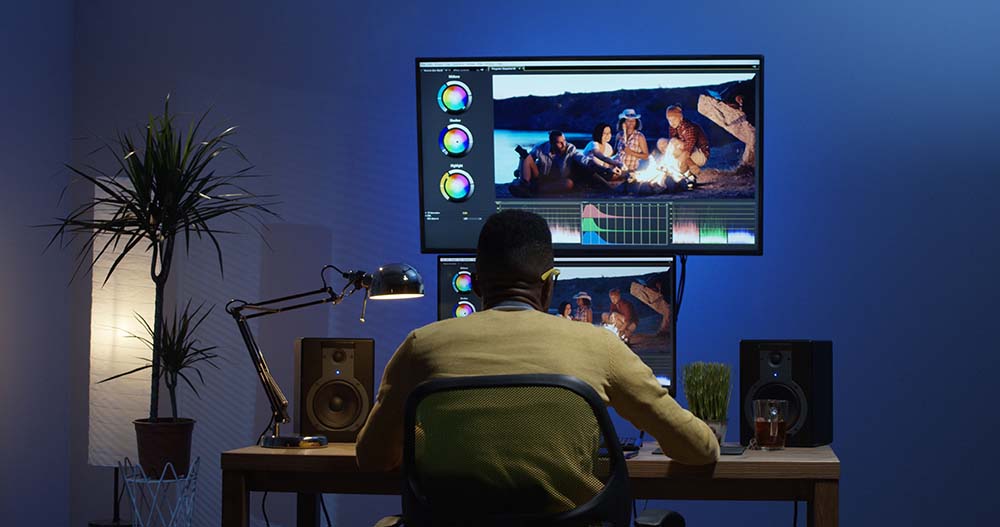How to Create a YouTube Intro Title Sequence With Video Overlay

Ever wonder how they made those amazing outer space scenes in Star Wars before CGI? Back in the golden age of film, filmmakers had to do all of their special effects in-camera without the use of computers. One of the most common techniques used, like those scenes in Star Wars, was masking.
- What is a Title Sequence?
- Great Examples of Title Sequences
- Video Overlay Tools to Create Title Sequences
- How to Make an Opening Title Sequence Using PowerDirector
Simply put, masking is the process of combining parts of two different images together into a single image. By leaving a portion of a frame ‘masked’ while filming or while doing a film transfer, a portion of the frame on the film remained unexposed. With this portion of the frame unexposed, the filmmakers could then go back and film or transfer another image onto the same frame! This is the magic of masking.
Today, masking is still one of the most common techniques used in video and film post-production and the capabilities of what you can do with masking on your own production are incredible. With digital editing technology, there are limitless ways you can use masks to create special effects or motion graphics for your video or film!
When used correctly, masking becomes a powerful storytelling tool that can help hook an audience – and what better time to do this than during your intro sequence! From text masking to image masking and beyond, you can draw an audience into your world, inform them, entice them, or even disturb them (thanks, Se7en).
In this article, we’re going to show you the power of masking to create your own intro sequence. Let’s take a look at the definition and purpose of a title sequence, and then dive into how you can make a YouTube intro video, intro sequence to a film, or other title sequences using masking to make it capture your audience.
What is a Title Sequence?
A title sequence is a standalone, concept-driven segment of a video, TV show, or film that helps anchor the viewer into the story they’re about to see. You know the sweeping opening to Game of Thrones that takes you all across their fantastical world via maps and epic music? Or, how about the slow-motion, totally laugh-out-loud-hide-your-eyes gory title sequence in Zombieland?
Both of these examples are wildly different, yet they both display the impact a great opening title sequence can have on a film. Far beyond white text on a black screen, these intros give us an access point to the tone, mood, or style of the world the viewer has decided to enter.
While it is important to clearly display the title as well as the essential cast and crew during your opening sequence, you are creating far more than that. With the help of graphics, music, and, yes, masking, you have the opportunity to draw your viewer in - and perhaps even provide some foreshadowing of what’s to come.
Think of your title sequence like the cover of a book - you want it to evoke the right emotion that compels the person holding it to open it up and start reading. If you wrote a love story, you don’t want your cover to look like a Stephen King novel, or vice versa. Much the same, an intro sequence needs to captivate and get the viewer into the right mood. This requires that you and your team spend time storyboarding, conceptualizing, and iterating your idea until it effectively gets across what you’re trying to say.
Intro sequences leverage a number of different aspects of design to achieve the desired result. From the color palette to the typography, animation to textures and lighting, you have the ability to meticulously bring together each piece of the puzzle until your sequence is as exciting as the film itself.
Great Examples of Title Sequences
The more you experience outstanding title sequences from the media of others, the more creative you will become. Let these two knock-out openers spark your inspiration and drive you to make your next intro sequence your best yet.
Counterpart
This sci-fi thriller’s intro sequence was designed to ground the viewer in reality, even though it has an out-of-this-world plot. Video masks and title reveal masking were both used along with digitally-designed graphics and real-world photography. This created an unsettling blend of textures and colors that makes us feel as though there’s something more going on beyond the cubicles and clocks of the everyday Berlin offices in which the show is set.
DRIVE: A Year of Adventures by Road
In this simple, yet effective opener, text masking is used to draw us into the film. The title fades in on a black background, and within the text, footage of a road in the wilderness is seen rushing by. This matches perfectly with the theme of the film, and shows how one easy masking technique can have a major impact on your film’s intro sequence.
Mission: Impossible: Ghost Protocol
The Mission: Impossible music is one of the most iconic in film history - as is the quintessential lit fuse traveling to its final explosive destination. This particular iteration in Ghost Protocol, however, is especially exciting. The title sequence gets the viewer prepared for the adventure to come with its 3D title text and video overlay effects. Title reveal masks are used throughout the opening sequence, along with video masks to bring in live action footage within motion graphics.

Video Overlay Tools to Create Title Sequences

Now that we’ve taken a look at some great intro sequences, let’s discuss how you can use masking to create stunning sequences of your own. The following are four major types of masking techniques, but within each of these are infinite ways to play and design. Once you know the different options, you can choose the right masking effect to suit your film or video’s unique style, tone, or world.
Text Mask
With text masking, you can create a video text overlay. This means that your footage can appear within the text you’ve added to the frame. The masked text can be as opaque or transparent as you’d like, depending on your desired effect.

You can also use this type of mask to overlay separate video footage on top of other footage. For this technique, one piece of footage would be seen within the text on the screen, and the other would play in the background around the text.
Title Reveal Mask
Title reveal masking works in conjunction with keyframes to place your text exactly where you want it, when you want it, and how you want it all throughout your intro sequence. Have you ever seen a title that appears from out behind an object in a video? This is an example of a title reveal mask. With this technique, you can set a title to be revealed from anywhere on the screen, seemingly from out of nowhere.
Without this type of mask in place, you can slide, drop, or swirl the title text in, but it will come from outside the edge of the frame - not ideal in every situation, and certainly limiting to your creative imagination.
Image Mask
Image masking allows you to isolate an image in your video and track it or anchor it to a specific point on the screen as it moves. Once you’ve created your mask, you can then play with the graphics and colors behind and around the image to achieve your desired result. You may have to adjust the mask as you go - it doesn’t always track all the way through - but this is a great way to achieve dynamic results that provide texture and tone to your sequence.
You can also invert this mask to create a blank space within the confines of your mask’s outline. You can then overlay an image or video sequence within that space. There are a number of tools that allow you to adjust the mask’s size, opacity, shape, and more. A shape mask can also be used to alter the look of your footage and also to hide or clone objects.
Mask Selection Tool
Your editing software will come with masking templates to use in your videos, but sometimes you need a more unique shape. The mask selection tool gives you the freedom to make a “connect the dots” organic mask shape for your desired area. The dropped nodes can be adjusted as you create the ideal outline, and can be dragged to create a curve, if necessary. Once you are happy with your mask shape, you can add additional nodes to customize the curves of certain areas, remove nodes, or make adjustments as your footage tracks.
You also have the ability to play with the settings of the mask once you’ve created it. For example, you can click and drag the entire mask and set a new keyframe, and you can also feather the mask to create a faded effect that eliminates sharp, distracting edges in your video.
How to Make an Opening Title Sequence Using PowerDirector

Ready to put your new knowledge to use on your next video intro sequence? With PowerDirector you have all you need to create stunning mask effects that take your title sequences from average to outstanding. With professional-grade features such as customizable motion graphic titles, dynamic keyframe controls, and more, you’ll be prepared to create on a whole new level. Learn more about how PowerDirector can enhance your editing experience today.
If you're an aspiring editor looking to create cool videos, head on over to our complete guide on video editing effects. We've also got other great articles in our blog that'll introduce you to all the tools you need to enhance your portfolio.





